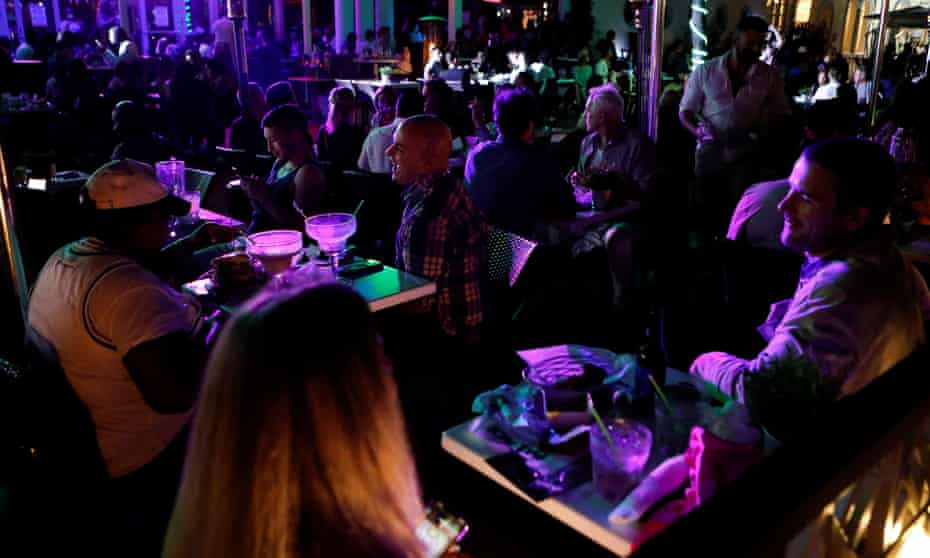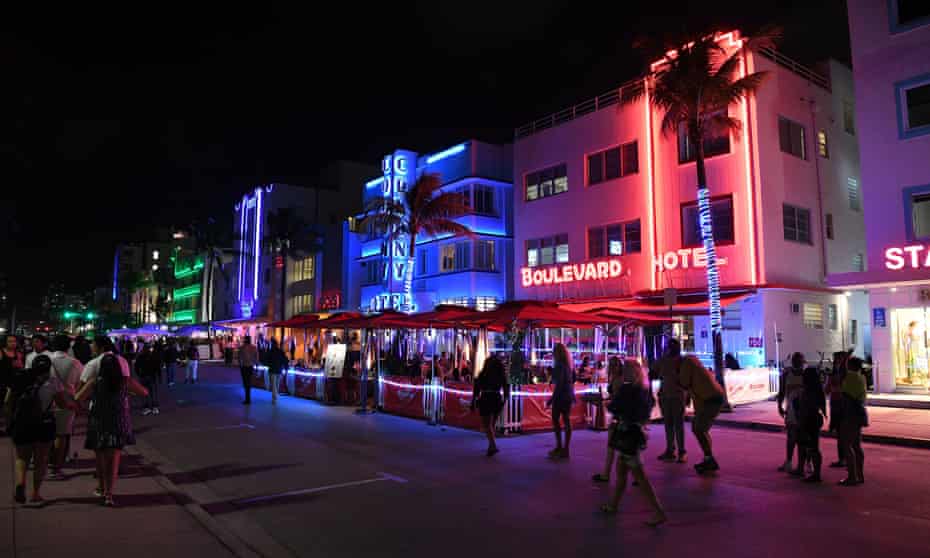Covid-19 and spring break have never mixed well. Last March one young, shirtless man in Miami wearing a backwards-facing green cap went “viral” in the pre-pandemic sense when he told a reporter: “If I get corona, I get corona,” he said. “I’m not going to let it stop me from partying.”
A year later, even after Covid has killed over 500,000 Americans, and the Centers for Disease Control and Prevention has recommended against all travel, similar pictures and videos of spring breakers – no masks or social distancing in sight – are being seen again this year.
“Florida hasn’t skipped a beat,” a college student from Michigan told the Sun-Sentinel of the atmosphere in Fort Lauderdale. The newspaper said the student was not concerned about the virus, saying “we’re not in the at-risk group”.
Even though the Covid vaccine is rolling out, the virus is still spreading in many parts of the country, albeit at lower numbers than the surge that was seen over the winter. Florida, the premier destination for spring break in the US, sees over 4,000 new cases of Covid a day, yet hotels in Miami are expecting hotel occupancy to reach 70% – just 15% less than pre-pandemic time.
“Cases may be coming down, but there’s plenty of Covid out there to circulate among people,” said Cindy Prins, an epidemiologist at the University of Florida.
Prins said the popularity of partying and drinking in large crowds during spring break makes it ripe for the spread of the virus.
“There’s a lot of drinking that goes on and people are more likely to let go of their inhibitions. That means that they’re going to be more likely to take off their masks, less likely to keep a physical distance from other people,” Prins said.
“Even the simple act of eating and drinking, you take off your mask to do that. That also puts you at a higher risk, especially at a crowded bar or restaurant.”
Though many restaurants and bars were closed to spring breakers last year, doors are once again open this year thanks to state orders. Even as Florida hit a peak number of new cases in January, the state has been in its third phase of reopening since September, meaning restaurants and bars can be opened at 50% capacity at the least.
While cities and towns deal directly with the fallout of an increase in Covid-19 spread, they have less power to enforce public health measures that would curb the spread of the virus as spring breakers arrive. An executive order from the Republican governor, Ron DeSantis, bans local Covid-19 emergency orders from reducing the capacity of bars to below 50%, except in rare exceptions. Localities also cannot enforce mask mandates, which has been a point of tension between some mayors in the state and DeSantis.

Dan Gelber, the mayor of Miami Beach, a town on an island directly east of the city of Miami, said the town has resorted to handing out masks to visitors to encourage masking. Policies like a midnight curfew and a ban on music at venues above ambient noise have been implemented to discourage rowdy partying. Still, Miami Beach has increased police and code-compliance presence in anticipation of an influx of travelers.
“The problem is that it’s dirt cheap to get on a flight [to Florida], rooms are available at discounts, people have been cooped up, and there is almost no other place to go,” Gelber said. “I don’t think we’re anywhere near the compliance we would like. We can’t impose fines on our mask mandate, and it does feel like a lot of the people coming here overwhelmingly are not worried at all.”
Colleges and universities have shouldered some of the responsibility in trying to rein in spring break travel and partying. Many schools, including some of the largest state schools, such as Ohio State University and Texas A&M University, have cancelled spring break entirely, opting to lengthen winter break and give students “wellness days” throughout the semester.

Still, a few schools have kept their spring breaks. Some have made pleas to students to avoid travel during their week off, even giving students incentives to stay on campus through campus events. The University of California at Davis is offering 750 students a $75 “staycation” stipend to spend at local businesses if they remain around campus during breaks.
Many college students will be following their schools’ guidelines, grateful that they get some time off after intense terms.
Samantha Mejia, a junior at the University of California at Davis, said volunteer commitments are keeping her on campus during spring break, but other students are, at most, planning on driving home for the week.
“No one’s doing big travel,” Mejia said. “For the most part, students here are generally safe.”
Kate Whitaker, a sophomore at the University of Chicago, said the school sent students and their parents emails urging them to stay on campus for their spring break, telling students that if they do plan on traveling, they will have to quarantine once they get back to campus. Whitaker plans to stay in Chicago for her break, using the time to unwind after a busy semester.
“We’re super grateful … to just have that time to not do anything because it feels like we’re always on during school, especially now that it’s all online,” Whitaker said.
Though thankful for the time off, some students with spring breaks are concerned about classmates who decide to travel.
Lily Hernandez, a junior at the University of Texas at Austin who plans to stay on campus for spring break, said that friends with in-person classes have overheard conversations of people who plan on traveling to places like Miami for spring break.
“It definitely worries me a bit knowing that I’m taking the precautions and just going to work, and a bunch of students are going to different locations,” she said. “It’ll just make me more cautious of going to campus to study, and maybe I’ll just stay home for the next few weeks.”
This content first appear on the guardian

Muchas gracias. ?Como puedo iniciar sesion?